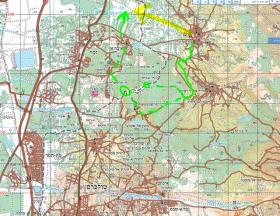Deir al-Ghusun
The head of the Atil Baladiya, a distinguished and eloquent man, takes us to the roof of an abandoned building which is situated exactly opposite the village’s hothouses. But they are beyond the fence, and the road that leads there is cut off by a gate, which is open only for the use of the army. In order to reach the hothouse, a distance of five minutes by foot(!!) they have to pass through gate no. 609 and then through Zemer, an Arabic Israeli community, a long distance. But this is not the worst; there, on Israeli territory, the (Israeli) Police or the Border Police often stop them and imposes high fines, or confiscates their vehicles.
A bit to the north is Gate No. 564, the Zeita gate, but it is opened only two days a
week, and there is no way from it to the Atil hothouses.

10:00 Dir El-A'usson
We meet our contacts, L. and M. at the well-kept Baladiya. The head of the village arrives too, but he speak very little Hebrew. We came to find out whether gate no. 623 was open. L. tells us that the inhabitants were indeed informed about the intention to close it, but again and again they approached the DCO and appealed against the closure . All this happened three months ago and since then the gate was open as before – three times a day.
. All this happened three months ago and since then the gate was open as before – three times a day.
I do not know how to interpret this responsiveness. Is it a tendency? It is known that Shoshi has succeeded in preventing the closure of the gate at Far'un. This is somehow encouraging. Perhaps we should form, together with the Palestinians, a mode of action versus the DCO?
According to L.'s testimony Dir El-A'usson has 2500 dunams beyond the fence, and they border on Zemer. The people of Zemer and Dir El-A'usson are one clan which has been separated by the fence.
They tell us again about the difficulties heaped by the soldiers on those who wish to pass by the gate, even on those who have permits. Today men from Kafin were sent back because they were dressed too well and had money (i.e., did not appear to be going to work).
The biggest problem is that for people who have a passage permit for one gate (for example, 623) but their plots are near another gate (609). They have to pass by the village of Yama, on Israeli territory, according to rumors at Atil the police fines them and confiscates vehicles. It is very difficult to change an entry permit from one gate to another.
11:00 We drive to Atil. We haven't coordinated the visit, so the head of the Baladiya isn't there. One of the clerks, R., a bright 22-year-old woman, calls him and said that he would arrive in about half an hour. We wait in the well-appointed office and talk with R. She is beautiful and very friendly. She tells us about her studies, her family, about her brothers, who are in Saudi Arabia. The conversation is fascinating. We exchange photographs and are offered drinks and sweets. An hour passes and the head of the village still isn't here.
Just before we decide to leave, the man arrives.
The big problem of Atil is that they don't have a gate which is close to their plots. They want to be allowed to pass by the gate that is situated a bit south to gate 564, which at the moment is open for the use of the army only. The situation is described in detail in the introduction.
I don't know how – if at all – it is possible to help them.
At 13:00 we go back.
